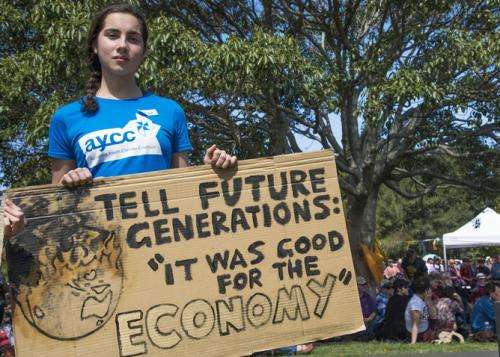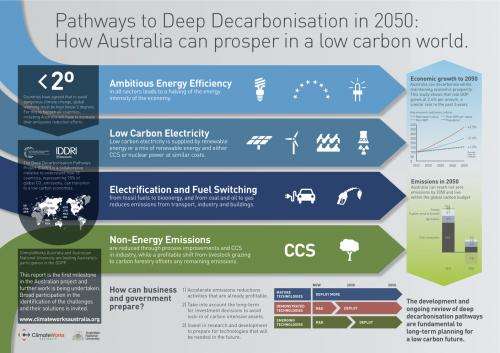Australia can get to zero carbon emissions, and grow the economy

Today more than 120 world leaders are gathered in New York for the Climate Leaders' Summit. With global emissions continuing to rise, it is easy to be pessimistic.
But new research released today shows that it is getting easier to achieve a very low emissions future for all major countries. Australia could go to zero net emissions by 2050, without compromising prosperity and with new economic opportunities if the world goes low carbon.
Deep Decarbonisation Pathways
The aim of international climate policy is to limit global warming to a maximum temperature rise of 2 degrees C above pre-industrial levels by mid-century. This requires global emissions to more than halve by 2050, then continue toward net zero.
At the summit, new research from 15 countries has been presented to the UN Secretary-General Ban Ki-moon to give confidence to these world leaders that near-zero carbon energy systems are achievable by all the major economies by 2050.
Australia is one of those top 15 emitting countries. The others are Brazil, Canada, China, France, Germany India, Indonesia, Japan, Mexico, Russia, South Africa, South Korea, the UK and the USA. Together they account for 70% of the world's greenhouse gas emissions.
An interim report by the UN Sustainable Development Solutions Network shows all 15 countries found ways to achieve near zero carbon electricity by 2050 while sustaining economic growth.
The Australian contribution is led by ClimateWorks and the Australian National University, and draws on modelling from the CSIRO and Victoria University's Centre for Policy Studies.
Australia's pathway to a low carbon economy
Our report published today shows the Australian options for deep decarbonisation of our economy while still maintaining economic prosperity, in a decarbonising world. The report, Pathways to Deep Decarbonisation in 2050: How Australia can prosper in a low carbon world finds that Australia can reach net zero emissions by 2050 while the economy continues to grow at a similar rate as today—2.4% of GDP per year.
Not only can we reach net zero emissions by 2050, this can be achieved without major structural changes to the economy, and minimal impact on Australians' lifestyles. Major technological transitions are needed in some industries and many activities, but no fundamental change to Australia's economy is required.
Other recent work goes further than our analysis in identifying economic and social opportunities from cutting emissions. The New Climate Economy project led by British economist Nick Stern points out a raft of policy options that will improve the quality of economic growth and help with climate change. Even the fiercest critics of this report do not seem to dispute that many options to cut emissions have substantial co-benefits for local environments, communities, and government budgets.
The pillars of decarbonisation
Australia's decarbonisation pathway relies on greatly improved energy efficiency across the economy, a nearly carbon free power system, and switching to low carbon energy sources in transport, buildings and industry. In addition to these three pillars that are common to all countries, Australia's pathway also involves reducing non-energy emissions in industry and agriculture.

The illustrative pathway modelled in the report found ambitious energy efficiency in all sectors leads to a halving of the final energy intensity of the economy between now and 2050.
The report also outlines three scenarios for decarbonising the electricity system. In one scenario, electricity is solely supplied from renewable energy. The other two scenarios also include renewables with a mix of carbon capture and storage or nuclear power.
The remainder of fossil fuel use in the economy is shifted to either bioenergy or low emissions fuel such as gas where possible, particularly for freight and industry. The analysis also shows the potential to entirely offset any residual emissions by carbon forestry plantings.
Action in economic sectors
Some parts of the Australian economy have excellent opportunities to reduce emissions.
First and foremost, the electricity sector has multiple options available to reach near zero emissions. Taking the carbon out of electricity is the backbone of a decarbonisation strategy for Australia, and it is easier than in many other countries that lack Australia's plentiful potential for renewable energy, as well as carbon capture and storage.
This can then flow through to emissions reduction in the buildings sector, given the relative ease to switch energy use in buildings to electricity.
Emissions from transport and industry are cut back substantially through energy efficiency and switching from fossil fuels to carbon-free electricity and biofuels or gas. It is not as easy in transport to switch to electric energy, so biofuels have an important role.
Non-energy emissions from industry are reduced through substituting with less emissions-intensive materials, process improvements and carbon capture and storage in some applications.
Agriculture emissions are reduced through best practice farming, but in some parts of agriculture opportunities to reduce emissions are limited, in particular from beef consumption, in substantial part for export.
Our report, based on new analysis by CSIRO, shows very large opportunities to sequester carbon in forestry. In our illustrative scenario, carbon sequestration increases over time to compensate for all remaining emissions at 2050.In aggregate, the scenario meets the carbon budget identified by the Climate Change Authority as compatible with Australia's contribution to a global 2 degrees C outcome.
New international advantage
If all countries take action to decarbonise their economies, Australia's abundance of low carbon energy opportunities could provide us with a comparative advantage. Whether the global energy system is high carbon or low carbon, Australia can be an energy superpower.
Australia is rich in renewables and geological storage, key resources for decarbonised energy systems. This could be the basis of a renewed advantage in energy intensive industries for Australia.
Australia also has large gas reserves—a transition fuel—and uranium, which can fuel nuclear power—a key component in many countries' decarbonisation strategies.
Time to act
Achieving deep emissions cuts requires a significant transition for Australia. The pathway identified is not a reconstruction of our economy, but it is a major upgrade of energy supply infrastructure and energy-using equipment and transport systems, along with rapid and large scale expansion of reforestation.
A successful low carbon transition requires a thorough understanding of the options, opportunities and challenges. It also needs long-term policy signals to encourage the investment decisions needed for a decarbonised economy.
A global effort is required to enable the world to reduce emissions, and indeed concerted global action is the frame of reference for our report. Australia must be ready to play its part, and to grasp the opportunities that can come.
Global greenhouse gas emissions continue to rise and it is getting more urgent to turn the ship around. Thankfully, it is becoming clearer that a very low-carbon economy is possible and will not compromise economic growth. It is not about a trade-off between economy and environment, it is about synergies.
Provided by Monash University



















